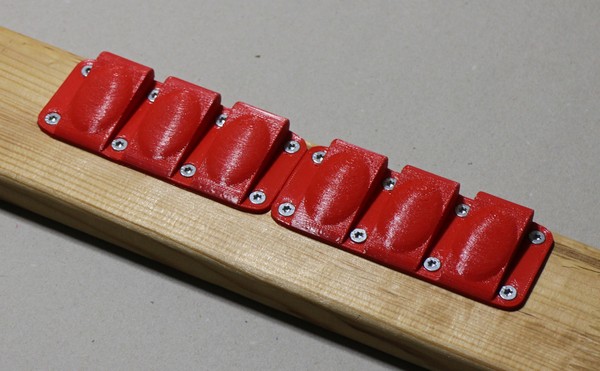Jig mode
The CLI utility’s --jig-mode parameter causes the utility to
output a model of a tool, instead of the default model of a keycap.
This tool is intended for use in the manual finishing of printed keycaps.
Specifically, controlled by the standard --bowl-radii parameter to the CLI
utility, the jig includes a pad with the same curvature as the bowl that tops
off a minimal-style keycap.
The pad on the jig curves outward while the bowl curves inward. You put a strip of sandpaper in between to make the inside of the bowl smoother, so it looks good and stays clean without the need for paint or varnish. Sanding the inside of the bowl is more important than sanding the sides. The jig will not help you do the latter.
Parameters
The following parameters to the CLI utility affect only its jig mode:
--jig-lanes. Leave this at the default value for a test print. Set it to 2 or higher to allow for multiple strips of sandpaper at once, which saves time in serial production.--jig-angle. You might need to adjust this for your workshop, but the default value is probably OK.--paper-width. Try to keep this close both to twice the size of the middle number in yourbowl-radiiand to the actual width of any sandpaper strips you already have lying around. Minor differences won’t matter.
The jigs shown in the image above were made with lein run --jig-mode --jig-lanes 3 --paper-width 22.
Printing
Sanding blocks are commonly made of cork or rubber to help make a smooth finish. The jig itself should ideally be printed in TPC or any similar, middling-soft material. A tire-like Shore hardness around D45 works well, with up to 1 mm top shell thickness and 15–20% gyroid infill. Keep the layers thin for a smooth pad.
Using a jig
By mounting a printed jig on a spare piece of wooden board and wrapping a strip of sandpaper around it, you complete the jig. You then take a printed cap and rub it on the curved pad.
More detailed instructions are available in this illustrated build guide.
Can you improve this documentation?Edit on GitHub
cljdoc is a website building & hosting documentation for Clojure/Script libraries
× close